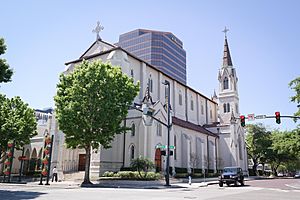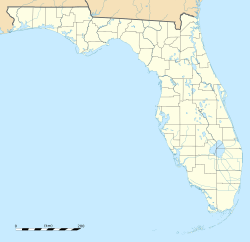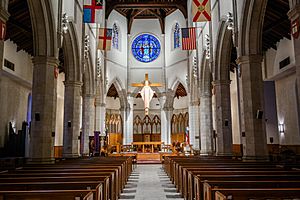Cathedral Church of St. Luke (Orlando, Florida) facts for kids
Quick facts for kids Cathedral Church of St. Luke |
|
|---|---|
 |
|
| 28°32′39.54″N 81°22′40.58″W / 28.5443167°N 81.3779389°W | |
| Location | 130 N. Magnolia Ave. Orlando, Florida |
| Country | United States |
| Denomination | Episcopal Church |
| Churchmanship | Anglo-Catholic |
| History | |
| Founded | 1892 |
| Architecture | |
| Architect(s) | Frohman, Robb, and Little |
| Style | Gothic Revival |
| Completed | 1926 |
| Specifications | |
| Number of spires | One |
| Administration | |
| Diocese | Diocese of Central Florida |
The Cathedral Church of St. Luke is a large and important Episcopal church, called a cathedral, in Orlando, Florida. It serves as the main church for the Diocese of Central Florida, which is a group of Episcopal churches in that area.
Contents
The Story of the Cathedral
How It All Began
The church's story starts with a man named Francis Eppes, who was the grandson of U.S. President Thomas Jefferson. Eppes was a dedicated member of the Episcopal Church. He moved to Orlando in 1869 when it was still a small town.
Eppes and a few other families started meeting for church services in their homes. This small group officially formed St. Luke's Mission in 1881. A "mission" is a small church that is just starting out. By 1884, it had grown enough to become a full parish, which is a more established church.
Becoming a Cathedral
In 1902, St. Luke's was chosen to be the cathedral for the area. A cathedral is the head church for a region, where a bishop has their main office. The first head priest of the cathedral, called a dean, was Reverend Lucien A. Spencer.
The church members decided they needed a new, bigger building. In 1922, they moved the old church building to make space. They hired a famous architectural company from Boston called Frohman, Robb, and Little. This company also designed the famous Washington National Cathedral.
Building the New Church
On April 13, 1925, a special ceremony was held to lay the cornerstone, which is the first stone placed when building something new. The church was partly built by 1926 and could be used for services.
However, Florida was having money problems at the time, so they couldn't afford to finish it. They put up a temporary wall where the altar was supposed to go. This temporary wall stayed there for 60 years!
Finally, between 1986 and 1987, the church was completed. The temporary wall was taken down, and the back of the church was finished just like the original plans. The finished cathedral now includes a beautiful apse (a curved area behind the altar), a bell tower, and a small chapel named for St. Mary.
Music at the Cathedral
The Famous Choirs
The Cathedral Church of Saint Luke is home to the well-known Orlando Deanery Boychoir and Girls Choir. These choirs are modeled after famous European church choirs and are connected to the Royal School of Church Music in England.
The choirs are a way for the cathedral to reach out to the community through music. They have traveled all over the world and have represented both Orlando and the United States. In 2011, they were invited to sing at the White House in Washington, D.C. In 2014, they performed at the famous Carnegie Hall in New York City.
The Pipe Organ
The cathedral has a very large pipe organ. It was the last one ever built by the Tellers Organ Company from Erie, Pennsylvania. It has 88 ranks, which means it has many sets of pipes to create a wide variety of sounds.
The organ was installed in a new gallery at the back of the church. The first official concert on the organ was played on October 21, 1973, by Paul Jenkins, a music professor from Stetson University.
See also



